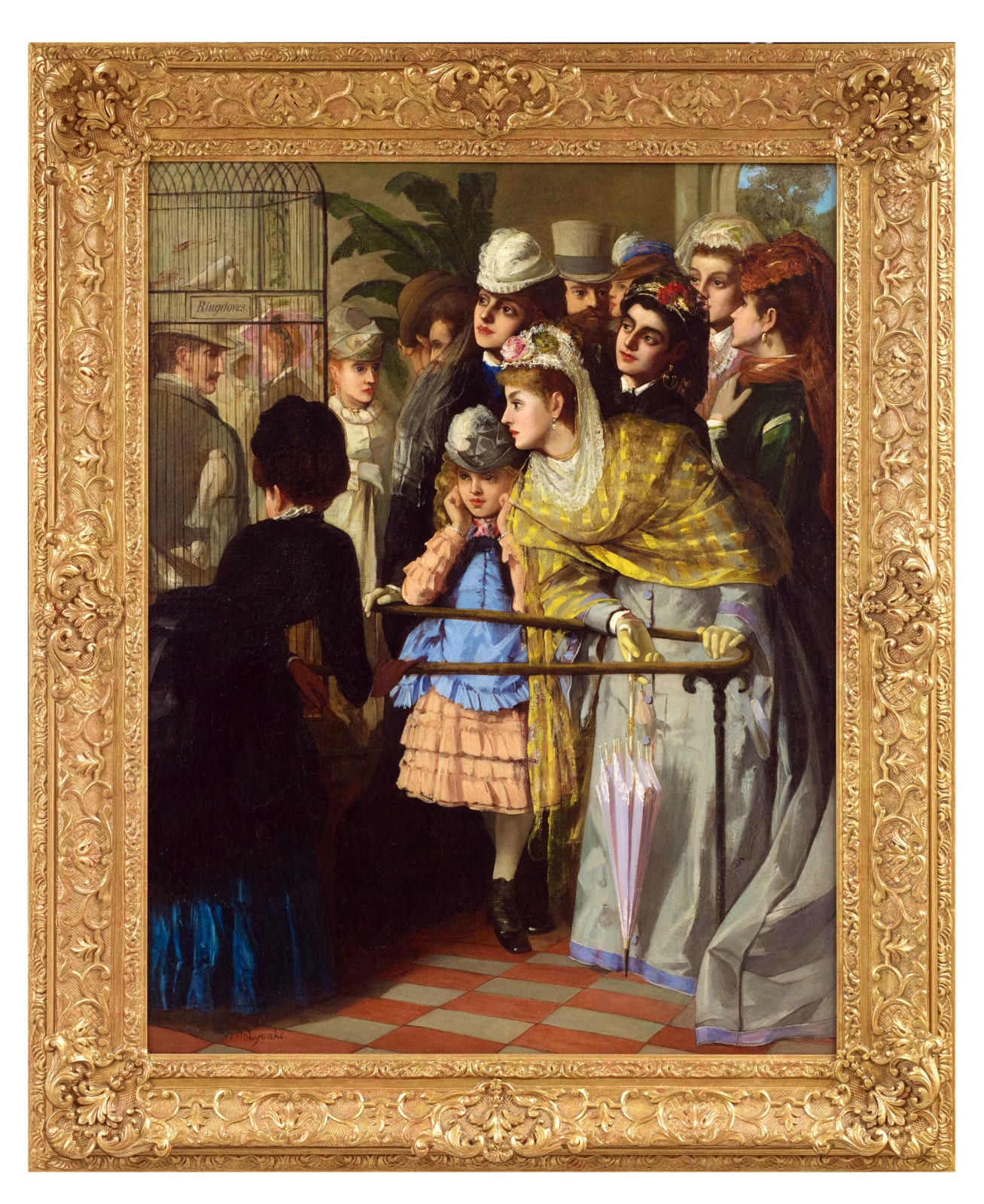William Holyoake 1834-1894
Exhibitions
Most probably his painting titled “The Captives”, shown at the Royal Society of British Artists, London, 1868, no. 379, priced at 15 guineas.
William Holyoake R.B.A. (1834-1894)
“The Captives”
Oil on canvas, signed (lower left) W. Holyoake
91 cm. x 71 cm.
This delightful genre scene by the eminent artist William Holyoake portrays the interior of an aviary where society figures, all dressed in the latest fashion, crowd together to admire some white ringdoves in their gilded cage as well as other birds that are out of site. Given its size, quality and subject matter the present oil is believed to be one of the artist’s two exhibits shown in 1868 at the Royal Society of British Artists, where in total he showed 53 pictures from 1879 up until 1888. Typifying Holyoake’s multi-group compositions in which he often placed one fine portrait beside another, it is full of anecdotal detail from the young girl in the central foreground who covers her ears to drown the noise of the birds to her mother standing beside her who is captivated by the captives as she leans against the brass railing. Surrounding them are men and women dressed in aesthetic outfits, whose manner reflects the white doves who historically symbolise love. Thus, one sees a gentleman in the background who doffs his hat to a young woman who, like the birds, is clothed in white and at the same time is being admired by another gentleman hidden behind the bird cage on the far left. Added to them in the background is a man in a top hat who, ignoring the birds, only has interest in an attractive lady wearing a green dress and seen in profile on the far right.
Holyoake was a master of contemporary and historical genre as well as being an excellent portrait painter. The present oil can be compared to several others by him, most notably “In the Front Row at the Opera” (Glasgow Museum and Art Gallery Collections) which likewise includes aesthetically dressed figures, some of whom are seen in profile and include an array of beautiful woman. These, like those shown here, can be likened to the ‘Stunners’ that featured in works by Dante Gabriel Rossetti, a co-founder of the Pre-Raphaelite movement and one of the leaders of the Aesthetic Movement, which gained momentum during the late 1860s. In addition to the above Holyoake’s paintings that can be admired in British public collections including his excellent portrait of his elder brother, the journalist George Jacob Holyoake (Birmingham Museums Collection), another of the Italian patriot Felice Orsini (1819-58) (Newcastle University) and “The Death of Major Peirson, 6 January 1781”, after John Singleton Copley (Royal Court House, Jersey).
Born in Birmingham in 1834, William Holyoake was the son of George Holyoake, a stationer and his wife Catherine née Groves. They had eleven children of whom William was their ninth child, born nineteen years after his eldest sibling. At the time of the 1851 census, when William was seventeen, he was still living with his parents and was working as a glass mould maker. However by 1859, two years after his marriage to Mary Catherin née Webster, he and his new wife had moved to St. Pancras London, where he began to earn a living from his paint and brush. This marked the beginning of his glittering artistic career, during which he exhibited at most of the major annual shows including the Royal Academy where he exhibited fourteen pictures between 1865 and 1885. His work also hung at the British Institution, the Royal Institute of Oil Painters, the Royal Society of Artists in Birmingham, Glasgow Institute of the Fine Arts, the Walker Art Gallery in Liverpool and Manchester City Art Gallery.
Elected a member of the Society of British Artists in 1879, Holyoake then become its Vice-President in 1887, while James McNeill Whistler was President. In 1888 Holyoake was among those who called for Whistler’s resignation. However, the two men had been on good terms, and in May 1884 Holyoake had been invited to the private view of Whistler’s recent exhibition at the Dowdeswell Gallery London. Such was Holyoake’s esteem that he was also twice the curator of one of the Royal Academy Schools, the last being curator of the Painting School from which he retired in 1870, where upon the Academy students organised a special dinner in his honour. William Holyoake and his wife Mary had three children of whom Rowland Holyoake (1861-1928) followed in his father’s footsteps, making his name as a genre and portrait painter as well as specialising in landscapes and interiors.
